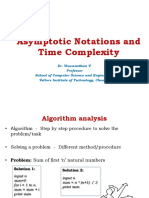0% found this document useful (0 votes)
101 views37 pages2 Program Complexities
The document discusses algorithms and their analysis, explaining that an algorithm is a sequence of computational steps to solve a problem, and that analyzing algorithms involves proving their correctness and analyzing their performance as problem size increases. It provides the example of insertion sort, explaining the sorting problem, how insertion sort works, proving its correctness, and analyzing its running time, showing it has quadratic worst-case time complexity.
Uploaded by
Dickson WongCopyright
© © All Rights Reserved
We take content rights seriously. If you suspect this is your content, claim it here.
Available Formats
Download as PDF, TXT or read online on Scribd
0% found this document useful (0 votes)
101 views37 pages2 Program Complexities
The document discusses algorithms and their analysis, explaining that an algorithm is a sequence of computational steps to solve a problem, and that analyzing algorithms involves proving their correctness and analyzing their performance as problem size increases. It provides the example of insertion sort, explaining the sorting problem, how insertion sort works, proving its correctness, and analyzing its running time, showing it has quadratic worst-case time complexity.
Uploaded by
Dickson WongCopyright
© © All Rights Reserved
We take content rights seriously. If you suspect this is your content, claim it here.
Available Formats
Download as PDF, TXT or read online on Scribd
/ 37



















































































